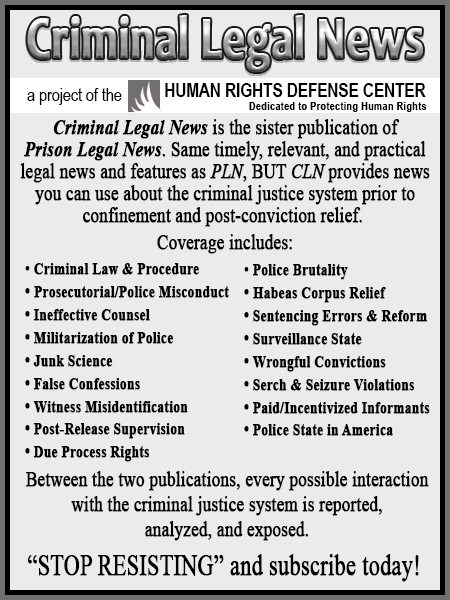×
You've used up your 3 free articles for this month. Subscribe today.
NYPD’s Controversial Use of Mugshot Database Searches
by Matt Clarke
The NYPD’s practice of using a crime victim or witness’ description of a perpetrator to generate a search of the department’s mugshot database, often generating hundreds of hits, has caused controversy and resulted in wrongful arrests.
New York City resident St. Clair Steward, 43, ...
Full article and associated cases available to subscribers.
As a digital subscriber to Criminal Legal News, you can access full text and downloads for this and other premium content.
Already a subscriber? Login
More from this issue:
- News In Brief
- When Prosecuting Crimes by Police, Feds Appear to Move Slowly, by Edward Lyon
- Can Criminal Records Ever Truly Be Expunged in the Internet Era?, by Matthew Clarke
- Third Circuit: Pennsylvania’s SORNA Requirements Sufficiently Restrictive to Constitute Custody for Habeas Jurisdiction, by Douglas Ankney
- Nebraska’s Death Row Prisoners Must Bring ‘Repeal Challenges’ Individually, by Douglas Ankney
- San Francisco Embraces New Technology to Clear Pot Convictions
- Wisconsin Considers Updating Its Cash Bail System, by Kevin Bliss
- Birth Pangs of Bail Reform Come to Texas, by Edward Lyon
- Indiana Supreme Court Announces Trial Court Must Resentence on All Underlying Felonies After Gang Enhancement Sentence Reversed on Appeal, by Derek Gilna
- $8.4 Million Combined Settlement Reached by ‘Norfolk Four’, by Douglas Ankney
- Eleventh Circuit Rules DEA’s Definition of Positional Isomer Does Not Apply to Substances on Temporary Schedule, Vacates Possession Conviction, by Matthew Clarke
- Shooting of Seven-Year-Old Girl in Houston Highlights Problems With Eyewitness Identification, by Matthew Clarke
- Georgia Supreme Court Announces Defendant May Invoke Rape Shield Statute to Bar State From Offering Evidence of Victim’s Past Sexual Behavior, by Douglas Ankney
- Kentucky Supreme Court Holds State Statute Defining Intellectual Disability as IQ of 70 or Lower Unconstitutional, Death Row Prisoner Entitled to Hearing, by Matthew Clarke
- Oregon Supreme Court Clarifies PCR ‘Church Motion’ Practice, by Mark Wilson
- Death Penalty Usage Trending Downward, Report Reveals, by Betty Nelander
- Tennessee Supreme Court: Attempting to Secretly Videotape Teen Changing Clothes Does Not Support Conviction for Attempted Production of Child Pornography, by Douglas Ankney
- Georgia Supreme Court Holds Statute Authorizing Lifetime GPS Monitoring of ‘Sexually Dangerous Predator’ Is Unconstitutional, by Douglas Ankney
- Erie County Convicted 11 People of Violating a Law Ruled Unconstitutional Over 20 Years Ago by Federal Court, by Kevin Bliss
- Video Simulators Part of Push to Train Police to Shoot Fewer Dogs, Limit Lawsuits, by Derek Gilna
- FBI Reviewing Four Incidents of Excessive Force at Mesa, Arizona, PD in Just Four Months, by Dale Chappell
- Law Enforcement and Lobbyists Battle Over Need for Civil Asset Forfeiture Reform, by Kevin Bliss
- First Circuit: Sentencing Courts May Consider New Career Offender Guideline Amendment 798, Even Though Not Retroactive, by Dale Chappell
- Nevada Supreme Court Clarifies, Narrows Nonhearsay Rule Under NRS 51.135(2), by Dale Chappell
- North Dakota Supreme Court Announces Implied Consent Advisory Must be Read After Arrest and Before Administering Test, by Douglas Ankney
- Counsel Ineffective for Failing to Move for Mistrial When Court Coerces Unanimous Verdict, by Douglas Ankney
- Fourth Circuit Rules 3 Marijuana Stems Discovered in Single Trash Pull Insufficient for Search Warrant, Suppresses Evidence Found in Residence, by David Reutter
- Sixth Circuit Rejects Qualified Immunity Claim in Malicious Prosecution Suit for Wrongful Arrest and Conviction Involving Multiple Lies by Police, by Dale Chappell
- Seventh Circuit: Claim for Unlawful Pretrial Detention Accrues on Date of Release, by Douglas Ankney
- Connecticut Supreme Court Announces Defense Counsel Has Duty to ‘Promptly’ Notify Defendant of Plea Offer, Failure to Notify Before Testifying Constitutes IAC, by Matthew Clarke
- In Landmark Civil Asset Forfeiture Case, U.S. Supreme Court Holds Excessive Fines Clause of Eighth Amendment Applicable to States, by Douglas Ankney
- Ninth Circuit Holds Juror Who Wouldn’t Unequivocally State She Could Be Impartial Should Have Been Excused; New Trial Ordered Because Biased Juror Can’t Be Harmless Error, by Dale Chappell
- Fourth Circuit Grants Habeas Relief for Death Row Prisoner Because Trial Court Excluded Expert Testimony Defendant Represents Low Risk of Violence in Prison, by David Reutter
- Supreme Court of Alaska Announces Court System Bears Costs of Expert Evaluation When Insanity or Diminished Capacity Raised as Defense, by Chad Marks
- Arkansas Supreme Court: Search of Wallet Exceeded Scope of Lawful ‘Terry’ Frisk for Weapons, by Douglas Ankney
- California Police Privacy Laws Have Been Violating Brady for Years, by Mark Wilson
- New Jersey Supreme Court: Detention of Motel Room Occupants After Reason for Police Visit Resolved Is Unlawful Seizure, Evidence Subject to Exclusionary Rule, by Richard Resch
- N.C. Supreme Court: Hiring and Paying a Hit Man Not Overt Act Necessary for Attempted Murder Charge, by Douglas Ankney
- NYPD’s Controversial Use of Mugshot Database Searches, by Matthew Clarke
- Conversations With Those Helped by Passage of First Step Act: Provides Relief for Some Federal Prisoners, but More Is Needed, by Chad Marks
- Appeals court provides new vehicle to challenge registration, by Larry N.
- The FBI Says Its Photo Analysis Is Scientific Evidence. Scientists Disagree., by Ryan Gabrielson
More from Matthew Clarke:
- Multitudes Caged for Failure to Pay Child Support, Driving Mass Incarceration, May 1, 2025
- Los Angeles County Pays $24 Million to Two Former Prisoners Wrongly Convicted as Teens of 1997 Murder, May 1, 2025
- Federal Watchdog Calls Out BOP for Spiking Suicide Risk at Pennsylvania Lockup, April 1, 2025
- Eighth Circuit: Arkansas Prisoner Who Had Consensual Sex With Guard Cannot Sustain Eighth Amendment Claim, April 1, 2025
- TDCJ to Run Out of Beds in 2025, April 1, 2025
- “Happy Mother’s Day”: $1,353,000 Settlement Approved for Migrant Parents Separated from Minor Kids at Border, March 1, 2025
- DOJ Finds “Horrific and Inhumane” Conditions in Georgia Prisons, March 1, 2025
- Sixth Circuit Upholds $6.4 Million Jury Award Against Corizon Nurses For Michigan Jail Prisoner’s Fatal Alcohol Withdrawal, March 1, 2025
- En Banc Fifth Circuit Reverses Panel, Holds Mississippi Felon Disenfranchisement Does Not Violate Eighth Amendment, March 1, 2025
- USDC (D. Oregon), Case No. 6:22-cv-00451, Feb. 15, 2025
More from these topics:
- Federal Government Circumventing Fourth Amendment by Buying Data From Data Brokers, April 15, 2025. Databases, Searches - Cellphones/Computers/Internet, Immigration Law/Offenses, Fourth Amendment.
- California Police Misused State Databases Over 7,000 Times in 2023, March 15, 2025. Police Misconduct, Databases.
- ‘Fictional Pleas’ and ‘Hidden Departures’: Failure to Collect Data on Binding Federal Plea Bargains Hinders Researchers, Feb. 15, 2025. Databases, Disclosure of Records, Public Records Act, Federal Rules of Criminal Procedure, Plea Agreements/Guilty Pleas.
- California Court of Appeal Announces Defendants May Obtain Brady Evidence From Police Officers’ Personnel Files in Advance of § 1172.6 Hearing Requesting Vacatur of Conviction and Resentencing for Certain Types of Murder Convictions, Feb. 15, 2025. Disclosure of Records, Police, Brady Violations, Murder/Felony Murder, Resentencing, Prior Conviction/Sentence/Incarceration, Evidence - Admissibility.
- Chicago’s Police Body Cam Transparency, Feb. 1, 2025. Videotaping, Police, Police State-Surveillance.
- You’d Better Watch Out: The Surveillance State Is Making a List, and You’re On It, Dec. 15, 2024. Databases, Police State-Surveillance.
- Forensic Genetic Genealogy: Police Are Searching Genetic Genealogy Companies’ Databases Regardless of Whether They Have Permission, Dec. 1, 2024. Databases, DNA Evidence.
- Minnesota’s $100 Million-Per-Year Civil Commitment Program Has No “Discernible Impact” on Sex Crimes, Oct. 15, 2024. Sex Offenders (Discrimination), Databases, Civil Commitment.
- Study Finds That Black Americans Want Both Police Presence and Reform: Looking Beyond the Headlines, Oct. 1, 2024. Criminal justice system reform, Police, Racial Profiling.
- Law Review Article Reports Metadata on Victims of Coercive Plea Bargaining, Sept. 1, 2024. Databases, Coercive Interrogations, Plea Bargaining.





